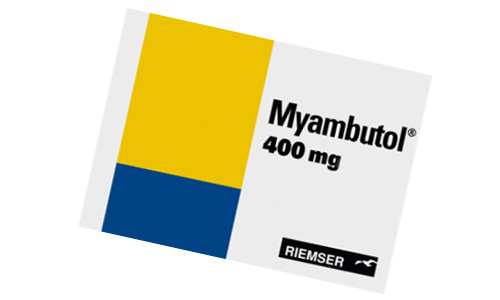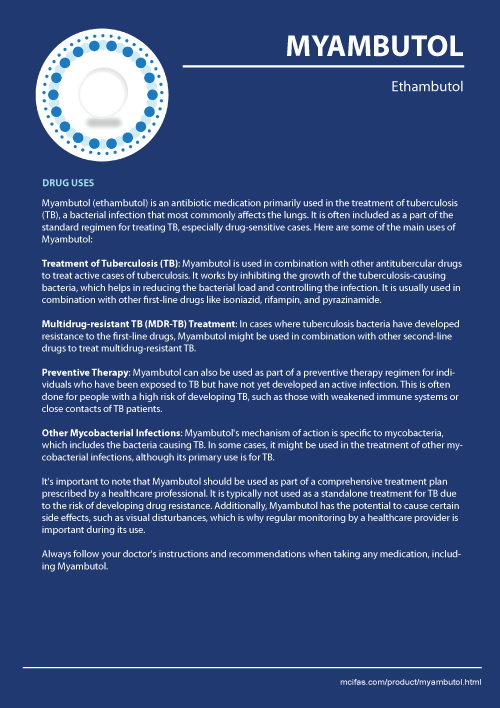Myambutol Prescribing Information
Myambutol is a group of antibiotic medications which are used to cure the primary symptoms of Tuberculosis. Fundamentally, these medicines are known to battle the manifestations of bacterial cells in the body. Aside from the greater part of the Tuberculosis, Myambutol is likewise used to fix various different illnesses, for example, Bronchitis, stomach ulcer, the runs, free movements and in addition different joint torments.

Uses of Myambutol
Myambutol is an antibiotic medication primarily used in the treatment of tuberculosis (TB), a bacterial infection that most commonly affects the lungs. It is often included as a part of the standard regimen for treating TB, especially drug-sensitive cases. Here are some of the main uses of this drug:
- Treatment of Tuberculosis (TB): Antibiotic is used in combination with other antitubercular drugs to treat active cases of tuberculosis. It works by inhibiting the growth of the tuberculosis-causing bacteria, which helps in reducing the bacterial load and controlling the infection. It is usually used in combination with other first-line drugs like isoniazid, rifampin, and pyrazinamide.
- Multidrug-resistant TB (MDR-TB) Treatment: In cases where tuberculosis bacteria have developed resistance to the first-line drugs, Myambutol might be used in combination with other second-line drugs to treat multidrug-resistant TB.
- Preventive Therapy: Medicine can also be used as part of a preventive therapy regimen for individuals who have been exposed to TB but have not yet developed an active infection. This is often done for people with a high risk of developing TB, such as those with weakened immune systems or close contacts of TB patients.
- Other Mycobacterial Infections: Myambutol's mechanism of action is specific to mycobacteria, which includes the bacteria causing TB. In some cases, it might be used in the treatment of other mycobacterial infections, although its primary use is for TB.
It's important to note that Myambutol should be used as part of a comprehensive treatment plan prescribed by a healthcare professional. It is typically not used as a standalone treatment for TB due to the risk of developing drug resistance.
Dosage
The dosage of Myambutol can vary based on factors such as the patient's age, weight, the severity of the condition, and any other medical considerations. It's important to follow the dosage instructions provided by your healthcare provider or the prescription label. Below are general dosage guidelines, but remember that only a healthcare professional can determine the appropriate dose for your specific situation.
For the treatment of tuberculosis (TB):
- Adults: The typical dosage for adults is usually around 15-25 mg/kg of body weight per day, taken as a single daily dose. This means that the total daily dose can be divided into one single dose. The maximum daily dose should not exceed 2.5 grams.
- Children: For children, the dosage is also based on body weight. The usual dose is about 20-30 mg/kg of body weight per day, taken as a single daily dose. The maximum daily dose for children should not exceed 2.5 grams.
- Renal Impairment: If a patient has impaired kidney function, the dosage might need to be adjusted to prevent accumulation of the drug in the body.
Side Effects of Myambutol
Myambutol can potentially cause a range of side effects. Not everyone will experience these side effects, and their severity can vary. It's important to be aware of the possible side effects and to discuss any concerns with your healthcare provider. Some common and less common side effects of Myambutol include:
- Visual Disturbances: One of the most significant side effects of Myambutol is changes in vision. This can include blurred vision, decreased visual acuity, and changes in color perception. These visual changes are usually reversible once the medication is discontinued, but they can be serious. Regular eye examinations are recommended during the course of treatment to monitor for any visual changes.
- Nausea and Vomiting: Some individuals may experience nausea, vomiting, or an upset stomach while taking Myambutol.
- Loss of Appetite: Loss of appetite can occur as a side effect, potentially leading to weight loss.
- Headache: Headaches are possible, although they are generally not severe.
- Joint Pain: Some individuals may experience joint pain or discomfort.
- Peripheral Neuropathy: Although rare, Myambutol has been associated with peripheral neuropathy, which involves numbness, tingling, or pain in the extremities.
- Fever and Chills: Fever and chills might occur as a side effect of the medication.
- Skin Rash: Skin rash or itching can be a potential side effect.
- Liver Function Abnormalities: Antibiotic might affect liver function, leading to abnormal liver enzyme levels in some cases.
- Dizziness: Some individuals might experience dizziness while taking this medicine.
- Elevated Uric Acid Levels: Myambutol can lead to increased uric acid levels in the blood, which could potentially lead to gout attacks.
Interaction with other drugs
Myambutol can potentially interact with other drugs, which could affect its effectiveness or increase the risk of side effects. It's important to inform your healthcare provider about all the medications, supplements, and herbal products you are taking before starting Myambutol. Here are some interactions to be aware of:
- Antacids and Aluminum-Containing Products: Antacids containing aluminum can reduce the absorption of Ethambutol. It's recommended to separate the administration of Myambutol and aluminum-containing antacids by at least 4 hours.
- Antiretroviral Drugs (for HIV): Medicine may interact with certain antiretroviral drugs used to treat HIV, potentially affecting their effectiveness. Your doctor will need to carefully consider the interactions if you're taking both Myambutol and antiretroviral medications.
- Certain Antibiotics: Some antibiotics, such as ciprofloxacin, might interact with Myambutol. This could potentially lead to increased risk of side effects.
- Vitamin B6 (Pyridoxine): Antibiotic can reduce the absorption of vitamin B6, potentially leading to deficiency. Your healthcare provider might recommend vitamin B6 supplementation while taking tablets.
- Cycloserine: There's a potential for increased central nervous system side effects when Myambutol is taken with cycloserine, another medication used to treat tuberculosis.
- Zidovudine (AZT): Myambutol can increase the risk of toxic effects of zidovudine, a medication used to treat HIV.
- Other Tuberculosis Medications: Myambutol is often used in combination with other drugs to treat tuberculosis. Your healthcare provider will carefully select a combination of medications that work well together and minimize interactions.
- Phenytoin: There have been reports of decreased levels of phenytoin (an antiepileptic drug) when taken with Myambutol, potentially requiring dosage adjustments.
What to avoid while on Myambutol
While taking Myambutol, there are certain things you should avoid or be cautious about to ensure the medication's effectiveness and minimize the risk of side effects. Here are some recommendations:
- Aluminum-Containing Products: Avoid taking antacids, sucralfate, or multivitamins that contain aluminum within 4 hours of taking Myambutol. Aluminum can interfere with the absorption of Ethambutol, reducing its effectiveness.
- Smoking: Smoking can also reduce the effectiveness of Myambutol. If possible, consider reducing or quitting smoking during the course of treatment.
- Other Tuberculosis Medications: If you're taking other medications for tuberculosis as part of your treatment regimen, follow your doctor's instructions carefully. It's important to take all your prescribed medications as directed to effectively treat the infection.
- Drugs with Known Interactions: Inform your healthcare provider about all the medications you are taking, including prescription drugs, over-the-counter medications, supplements, and herbal products. This will help your doctor monitor for potential interactions and make any necessary adjustments.
- Alcohol: While there is no specific interaction between this antibiotic and alcohol, it's generally a good idea to avoid excessive alcohol consumption while on any medication. Alcohol can affect your liver and overall health, potentially impacting your body's ability to metabolize medications.
- Driving and Operating Machinery: Medicine may cause dizziness or other visual disturbances, which could affect your ability to drive or operate heavy machinery. If you experience such side effects, it's best to avoid tasks that require clear vision and focused attention.
- Vitamin B6 Supplements: If your healthcare provider has recommended vitamin B6 supplementation due to the potential for Myambutol to affect vitamin B6 absorption, make sure to follow their instructions regarding timing and dosage.
- Taking Medication Without Medical Supervision: Never start, stop, or adjust your Myambutol dosage without consulting your healthcare provider. Any changes to your medication regimen should be discussed with your doctor.
- Skipping Doses: It's important to take Myambutol consistently and as prescribed. Skipping doses or stopping treatment prematurely can lead to the development of drug-resistant tuberculosis bacteria.
- Changes in Diet: While there are no specific dietary restrictions with Myambutol, maintaining a balanced diet and staying hydrated can support your overall health and immune system during treatment.
Contraindications of Myambutol
Contraindications are specific situations or conditions in which a medication should not be used due to the potential for serious risks or adverse effects. In the case of Myambutol, there are certain contraindications that should be taken into consideration before starting the medication. It's important to discuss your medical history and any existing conditions with your healthcare provider to ensure that Myambutol is safe for you to use. Some contraindications for Myambutol include:
- Known Hypersensitivity: Remedy should not be used in individuals who have a known hypersensitivity or allergic reaction to Ethambutol or any of the other ingredients in the medication.
- Optic Neuritis or Visual Disturbances: Medicine is associated with potential visual disturbances, and it should not be used in individuals with preexisting optic neuritis (inflammation of the optic nerve) or significant visual impairment. People with impaired vision, especially color vision, should be evaluated thoroughly by an ophthalmologist before starting Myambutol.
- Children Too Young to Report Visual Changes: Myambutol may cause visual disturbances that might not be easily communicated by young children. Therefore, it might not be appropriate for children too young to report changes in their vision.
- Severe Renal Impairment: Myambutol is primarily eliminated through the kidneys. In cases of severe renal impairment (kidney dysfunction), the dose of Ethambutol may need to be adjusted or the medication may need to be avoided altogether.
- Pregnancy and Breastfeeding: While Myambutol is not known to be highly toxic during pregnancy, there is limited information available about its safety. It is generally recommended to use caution during pregnancy and only use Myambutol if the benefits outweigh the potential risks. The use of Ethambutol during breastfeeding should also be discussed with a healthcare provider.
- Cognitively Impaired Patients: Myambutol requires careful monitoring of visual function, and individuals who might not be able to communicate changes in vision (such as those with cognitive impairment) should be evaluated carefully before starting the medication.
- Concurrent Medications: The medication's interactions with other drugs and medical conditions should be carefully evaluated by a healthcare provider before prescribing Myambutol.
Pregnancy and Myambutol
The use of Myambutol during pregnancy requires careful consideration and discussion with a healthcare provider. While drug is not known to be highly toxic during pregnancy, there is limited information available about its safety for pregnant women and their developing fetuses. As a result, the decision to use Myambutol during pregnancy should be based on a thorough assessment of the potential risks and benefits.
Here are some key points to consider regarding Myambutol and pregnancy:
- Risks and Benefits: During pregnancy, the safety of both the mother and the developing fetus is of paramount importance. Your healthcare provider will weigh the potential risks of using Myambutol against the benefits of treating the underlying condition, especially if you have active tuberculosis (TB). The decision will be individualized based on your specific situation.
- Optic Neuritis: Myambutol can lead to visual disturbances, which might pose an additional concern during pregnancy. Regular monitoring of your vision is important, especially during pregnancy, to detect any changes that could affect your eyesight.
- Combination Therapy: The standard treatment for tuberculosis usually involves a combination of several medications, including Myambutol. The entire regimen's safety and effectiveness need to be considered when evaluating treatment options.
- Consultation: If you are pregnant or planning to become pregnant and you are diagnosed with tuberculosis, it's crucial to consult with both your obstetrician/gynecologist and an infectious disease specialist or healthcare provider who is experienced in managing tuberculosis. They will work together to determine the best treatment approach for you and your baby.
- Breastfeeding: Ethambutol can pass into breast milk, although the levels are generally low. The decision to breastfeed while taking this medicine should be made in consultation with your healthcare provider, weighing the potential benefits of breastfeeding against the potential risks to the infant.
- Individualized Approach: Every pregnancy is unique, and the decision to use Myambutol should be based on a comprehensive evaluation of your medical history, the severity of your condition, and the potential impact on both you and your baby.
» Drug Uses (format pdf, 0.2 Mb)



